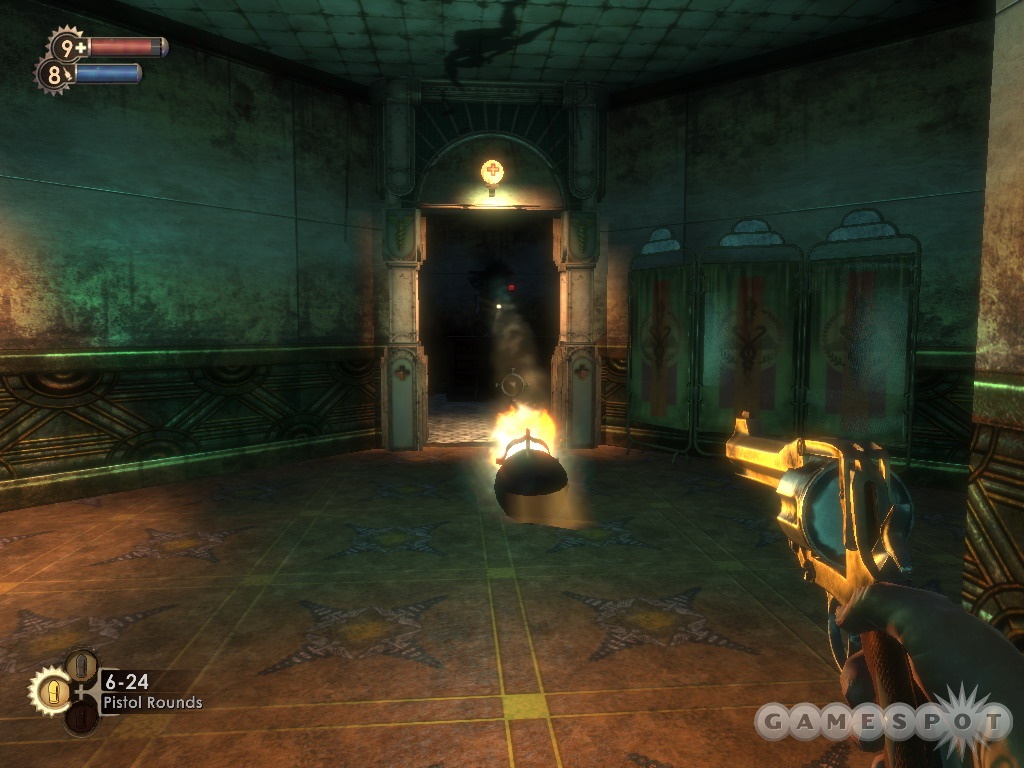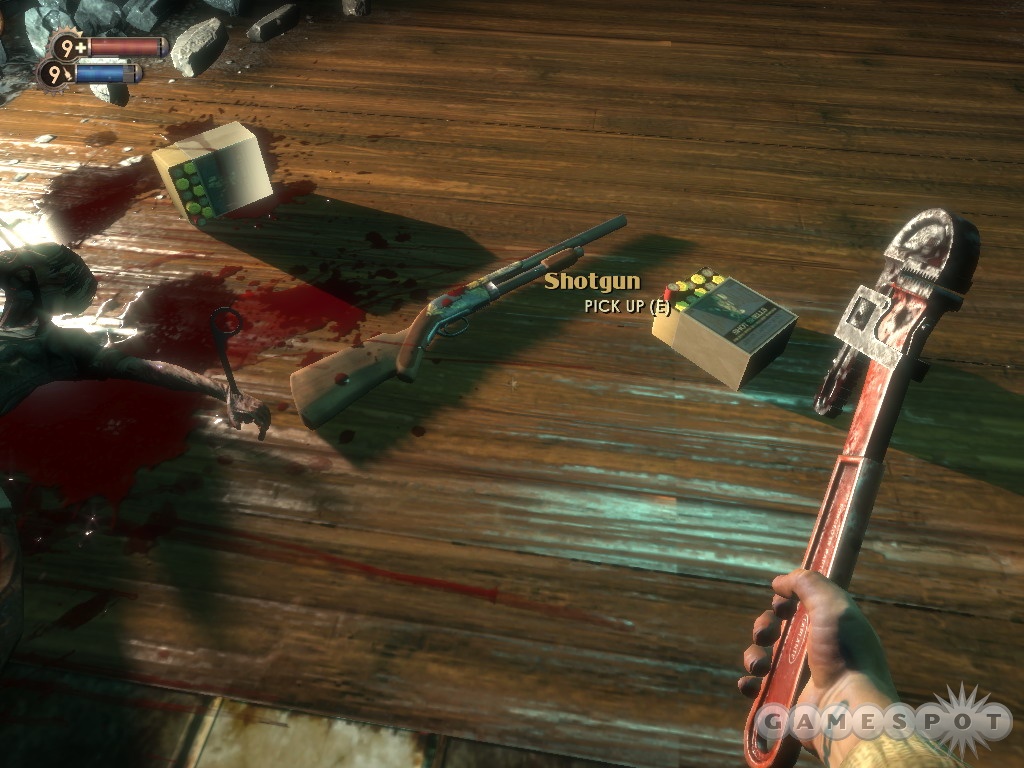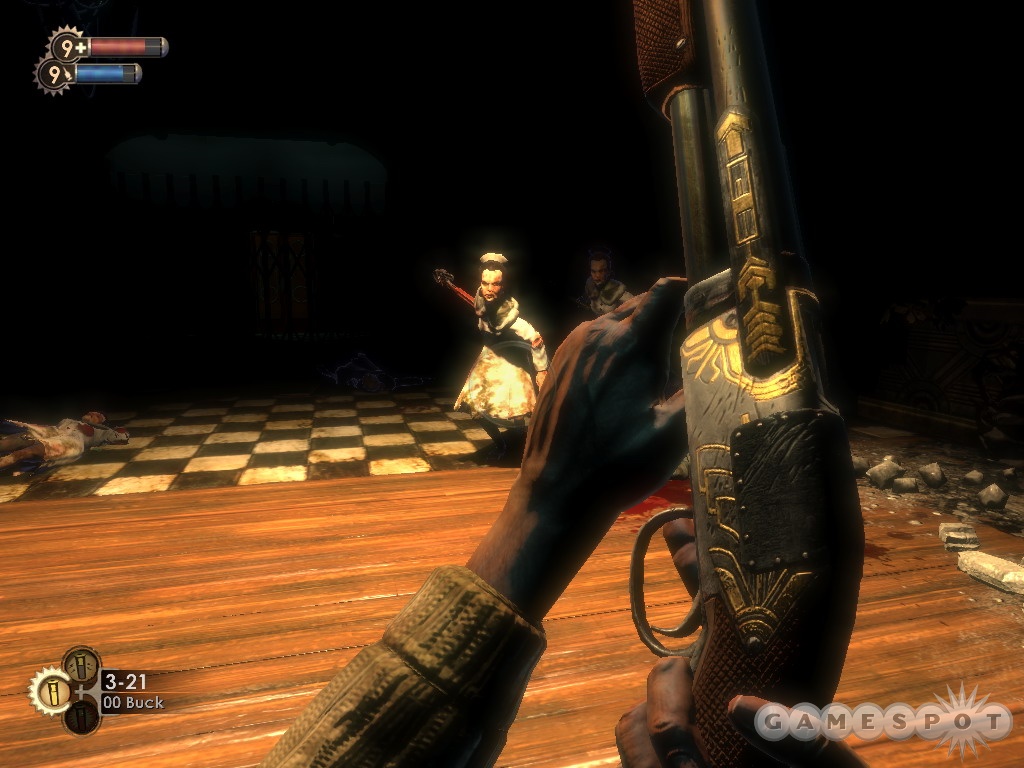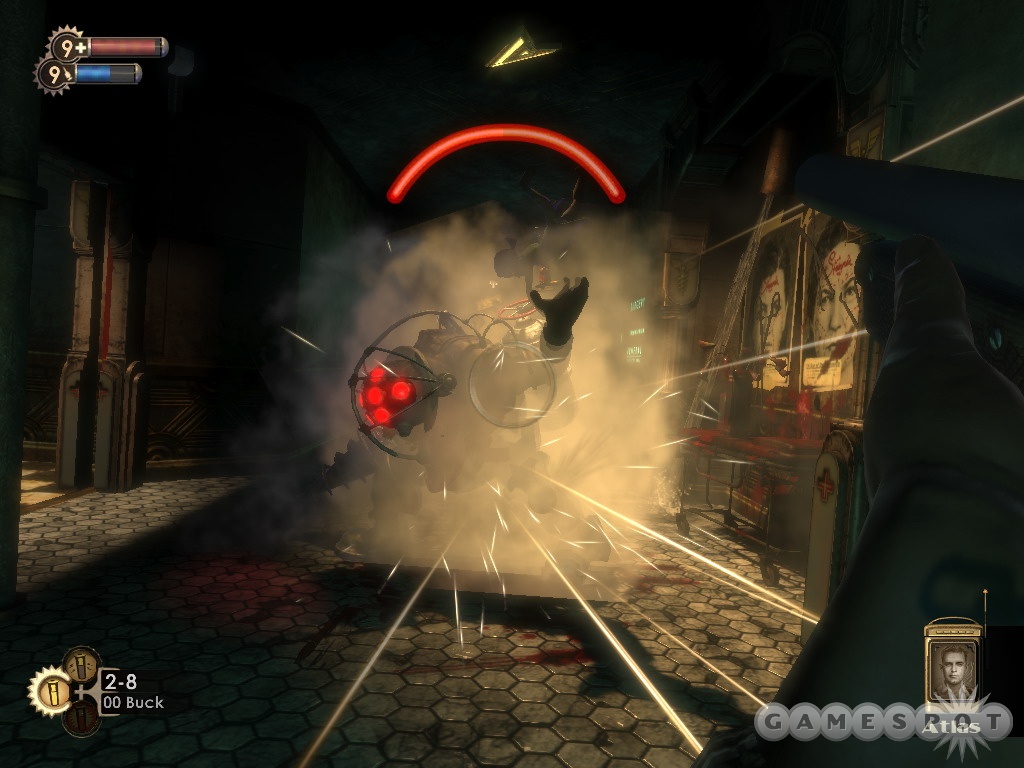While on the surface it might look like little more than a very pretty first-person shooter, BioShock is much, much more than that. Sure, the action is fine, but its primary focus is its story, a sci-fi mystery that manages to feel retro and futuristic at the same time, and its characters, who convey most of the story via radio transmissions and audio logs that you're constantly stumbling upon as you wander around. All of it blends together to form a rich, interesting world that sucks you in right away and won't let go until you've figured out what, exactly, is going on in the undersea city of Rapture.

BioShock opens with a bang, but the overall plot focuses more on making an emotional impact than an explosive one. The year is 1960, and you're flying over the Atlantic Ocean. One mysterious plane crash later, you're floating in the water, apparently the lone survivor, surrounded by the flaming wreckage of the aircraft. But there's a lighthouse on a tiny island just at the edge of your view. Who in their right mind would put a lighthouse this far out? You swim closer and discover a small submersible called a bathysphere waiting to take you underwater. After catching a breathtaking view of what's below, you're sent into the secret underwater city of Rapture. Masterminded by a somewhat megalomaniacal businessman named Andrew Ryan, this city is driven by its own idea of total freedom, with capitalism completely unhindered by governmental meddling and science unhinged from the pesky morals of organized religion. Sounds like the perfect society, right? Well, even before you step out of your bathysphere and into the city, it becomes obvious that everything has gone horribly wrong down here. The city is trashed, and genetic freaks called splicers roam around, attacking anything that gets in front of them. At the heart of the matter is a powerful, corrupting substance called ADAM, which makes all this genetic tinkering possible and allows you to get your first plasmid power, the ability to shoot lightning out of your fingertips.
Character customization is a key trait in BioShock. You have a limited but increasable number of spaces in various customization categories, and you can totally reconfigure all of your different plasmids and tonics at will, at no charge, at specific locations in-game. Plasmids are the active, weaponlike genetic enhancement. Many of these are very straightforward. Incinerate lets you burn things and melt ice. Telekinesis lets you use your left hand as if it were Half-Life 2's gravity gun. But others are a little more subversive. Security bullseye is a little ball you can toss at enemies, causing any nearby security cameras, turrets, or sentry bots to point in his direction. Enrage can cause enemies to fight one another. Insect swarm causes your arm to shoot bees at your enemies, which unfortunately is far less cool-looking than it sounds. You can also place decoys, plant swirling wind traps for enemies, and so on. While it's fun to mess around with a lot of the indirect attacks, facing your enemies head-on with the more direct plasmids feels a bit more effective.
Tonics are skills that are slotted just like plasmids, but they have passive effects, like sportboost, which increases your movement and melee attack speed, or natural camouflage, which makes you turn invisible if you stand still for a few seconds. So if you want to make your swinging wrench attacks more powerful, you can slot up things like wrench jockey and wrench lurker, which increase your wrench damage on all attacks and when catching opponents off-guard, respectively. Add bloodlust, which gives you some health back every time you club someone with your wrench, and you're a melee master with health and plasmid energy (called EVE) to spare. You can also slot some defensive stuff, like static field, which zaps anyone who touches you with a electric radius effect, and armored shell, which reduces the damage you take from physical attacks. There are more than 50 tonics to collect, giving you plenty of options to play around with.

Most of those plasmids and tonics will have to be purchased using the raw ADAM that you collect from harvesting vessels called little sisters. They're little girls with a big needle that they use to collect the sought-after stuff from dead bodies, and they're protected by the baddest enemies in the entire game, hulking armored monsters called big daddies. This is where the game makes you decide to be selfless or selfish. If you harvest the girls, they die, but you get 160 ADAM from them. If you free them and return them to normal, you get only 80 ADAM. There are a limited number of girls to deal with in the entire game, making it very possible that you won't be able to collect every single purchasable plasmid and tonic, so choose wisely. Either route has benefits and consequences, and there are story considerations as well.
Before you start thinking this is some kind of role-playing game or something, let's stop right here and say that in addition to all the toys that plasmids and tonics for you to play around with, you're also going to be carrying around some more conventional firepower. Your melee weapon is a wrench, and you quickly collect a pistol and machine gun. Being that this is 1960 filtered through the isolation of an undersea world that has the art deco style of the first half of the century, the weapons aren't nearly as high-tech as the genetic code in your body. The machine gun is your basic tommy gun, and the grenade launcher appears to have been cobbled together from coffee cans and other spare parts. You'll also get a shotgun, a crossbow, and so on. You can also collect different types of ammunition, such as exploding buckshot for your shotgun or missiles for your grenade launcher, and upgrades that increase damage, speed up reloads, and so on. The weapons are functional and the upgrades are pretty good, but the firing action isn't nearly as exciting as a combat-focused first-person shooter would be. The weapons are loud but don't feel especially right, and seeing shotgun blasts not even do 50 percent damage to an unarmored human target (on the default difficulty setting) just feels wrong. But that might also say something about the general lack of enemy variety.
There are five types of splicers to deal with, and these are your primary enemies. The splicers are humans who have messed around with ADAM too much and have essentially lost their minds. Now they wander around the city like junkies in need of a fix. The only real difference among them is what they're carrying. Leadheads have guns, thugs have blunt objects, nitros toss explosives, Houdini splicers can teleport and shoot fireballs, and spider splicers can crawl on ceilings and toss hooks at you. As you go through the game, they get tougher to kill, but there's no real visual indicator as to why that's so, leading to some of the weapons feeling a bit weak. Headshots simply shift from killing enemies immediately to not killing enemies immediately. This makes smart use of a combination of plasmids and conventional weapons the best tactic, though even those tactics don't involve much. The same one-two punch of shocking enemies to stun them and following up with a whack with the wrench is a perfectly viable tactic throughout the entire game, depending on how you've placed your tonics.

You'll find more important human characters at certain points in the story, and though these are set up like boss fights, these guys are just more powerful and resilient versions of existing splicers. You'll also have to deal with security robots, turrets, and cameras, though these can all be hacked via a neat little hacking minigame to bring them over to your side, allowing for more indirect combat options.
Then there's the big daddy, which comes in two configurations. The bouncer has a huge drill arm that is used to, you know, drill into people. The rosie likes to launch explosives in your general direction. Both of them are fairly nasty, because they move quickly and dish out a lot of damage while not taking very much from most of your attacks. They protect the little sisters, who are invulnerable to your attacks and can only be dealt with once their protecting big daddy is dead. The big daddy is hardly unbeatable, though you may die a few times while facing your first few. Death in BioShock is barely even a setback. When you die, you're reconstituted at the nearest vita-chamber and sent on your way with your inventory intact and most of your health.
This isn't a reload, so everything is as you left it, even the damage that you've already done to any surviving enemies. So you can wear down a big daddy by just running at it again and again with little or no care for your health. That can get tedious, of course, but having that possibility is a blessing--and a curse. On one hand, you're free to try out new things, like plasmid and tonic combinations, with no penalty if you equip some bum techniques. On the other, there aren't any real gameplay consequences, so playing with skill isn't rewarded. You could fumble your way through the 15 or 20 hours it'll probably take to properly explore Rapture and still see everything there is to see. This, along with three selectable difficulty settings, leaves you with the impression that the game was made to cater to a wide audience, but the hard difficulty setting doesn't actually impact things like artificial intelligence or force you to play any more skillfully to succeed. The enemies still mostly run at you mindlessly while attacking, occasionally getting into scraps with one another or breaking off to find a healing machine, but they take longer to kill and hurt you more when they hit.
While the world of Rapture is rich and filled with interesting little tidbits, the game does a tight job of keeping you on track. Aside from two cases where you must collect a certain amount of specific items in order to proceed, you always know exactly what to do and where to go to do it, thanks to a handy map screen and an onscreen arrow that points you directly at the next objective. These helping hands feel almost a little too helpful, but in the event that you get really stuck, you'll appreciate the additional hint system that very plainly explains what you need to do and where you need to go to move forward.
You won't miss a ton of locations by sticking to exactly where the arrow points you, but the story fills out a lot more when you find and listen to as many audio diaries as possible. Hearing various characters talk about the problems leading up to Rapture's current disheveled state really fills in the blanks nicely and should be considered mandatory if you intend to play the game. Hearing the voices of these wide-eyed idealists as their world falls apart makes the whole game feel more human. Playing through without listening to any of these optional audio clips would make the game quiet and, actually, fairly confusing, as you'd be proceeding with no sense of backstory about Andrew Ryan, fish magnate Frank Fontaine, and the bit characters who comment on their increasingly hostile struggle.
It certainly helps that the environments you find throughout the game look amazing and practically beg to be explored. For something as potentially dingy as an underwater city, you sure do get a lot of different looks as you move along, from the boiler rooms and workshops of the city's core to the forest that helps keep the entire thing oxygenated. You'll also get a lot of great views of the sea through windows. In addition to a terrific artistic design that ties the visuals together, the game has a very strong technical side, provided you have a machine that's built enough to handle it. Unreal Engine 3 is under the hood, and all the requisite bells and whistles are along for the ride. If there's one thing you need to know about BioShock's graphics, it's that the water looks perfect. As an underwater city that's slowly falling apart, it's no surprise that you'll find plenty of leaks. Whether it's standing water on the floor or sea water rushing in after an explosion, it'll blow you away every time you see it.
But BioShock isn't without flaw. The game has been released with a host of technical issues, ranging from a total lack of audio on some machines to issues with the SecuROM online activation, which under normal circumstances is designed to prevent you from activating a retail copy on more than two machines. The game is also available through Steam, though all of the same audio stuttering and other issues that some players are experiencing in the disc-based version carry over to the digital version as well. While it's a sad truth that no game is ever released in a completely bug-free state for 100 percent of its users, these issues appear to be pretty widespread, and if you're at all skittish about waiting for a patch after you've purchased something, you might want to wait until at least one patch is released before buying BioShock. In our experience, we got the game running with some minor audio stuttering on a Windows XP PC, and can't get any audio at all on our Vista test machine. All of this makes the Xbox 360 version's stuttering issues (which seem to only happen on some consoles) pale in comparison.
Aside from having different technical problems, the differences between the Xbox 360 and PC versions of BioShock are fairly minor. The mouse and keyboard support works exactly as you'd expect, and using a mouse makes the combat a touch easier, since aiming for the head is usually easier with a mouse than with a gamepad. But if you're after that console-style gamepad experience, BioShock has full support for the wired Xbox 360 controller. If you're at a loss for which version to purchase, it comes down to the quality of your PC. If you're running a high-end DirectX 10 machine, the game looks better on the PC. It also has DirectX 9 support, and even running this way, it's possible for some facets of BioShock, like texture quality, to look sharper than the 360 version if your machine can handle it. But when you factor in the current bug list for each version, or if your PC isn't especially recent, the Xbox 360 version is a safer bet.

In addition to some nice period music that plays from jukeboxes or record players, you'll get some terrific music that helps set the creepy, uncertain mood. The weapons sound good and loud, and everything else just sounds right. The voice acting, which you'll hear plenty of throughout the game from both living characters and their posthumous audio recordings, really brings the story together and helps give it all an emotional impact that most games lack. You'll also hear splicers mumbling, humming, and singing to themselves as they scavenge the environment, which helps give the game a creepy vibe. The quality and depth of things like this are what set BioShock apart from other games and make it something really special overall.
If you're the kind of player who just wants yet another action-packed shooter, BioShock probably isn't for you. Its weak link is its unsatisfying no-skill-required combat, which might aim this one just over the head of the average Halo fan. But if you want to get a little fancy, there's a lot of fun to be had with some of the game's more indirect fighting methods. It builds an amazing atmosphere by using terrific graphics and sound to set a creepy mood. But BioShock's real strengths are as a compelling work of interactive fiction, and as a unique ride through a warped world with some great payoff built into its mysterious plot. If that description has you even the least bit interested, you'll definitely find BioShock worth playing--but you still might want to hold off for a patch or two, just in case.